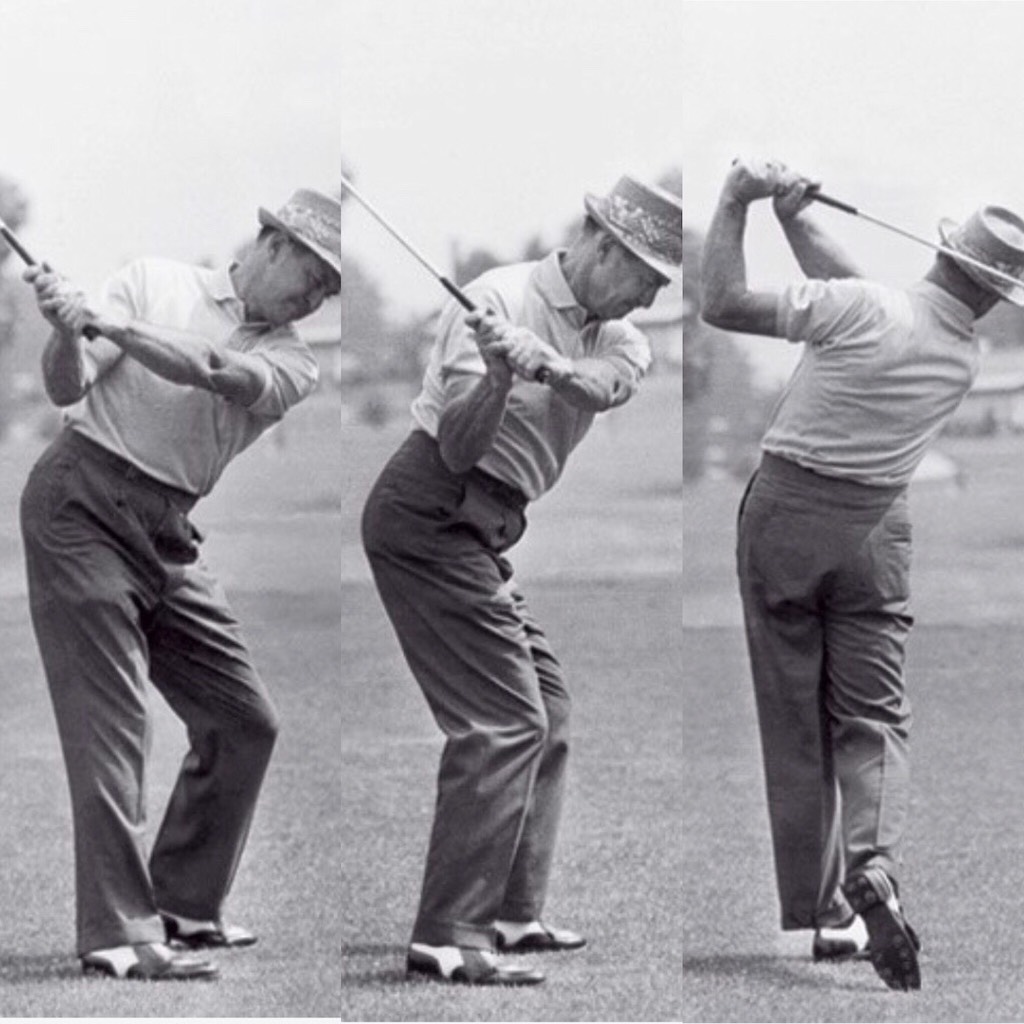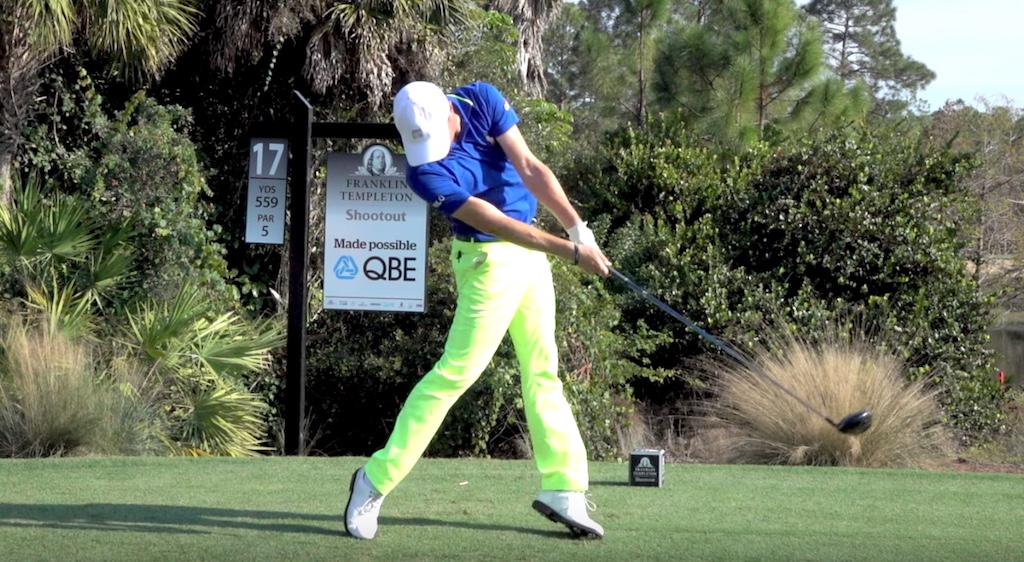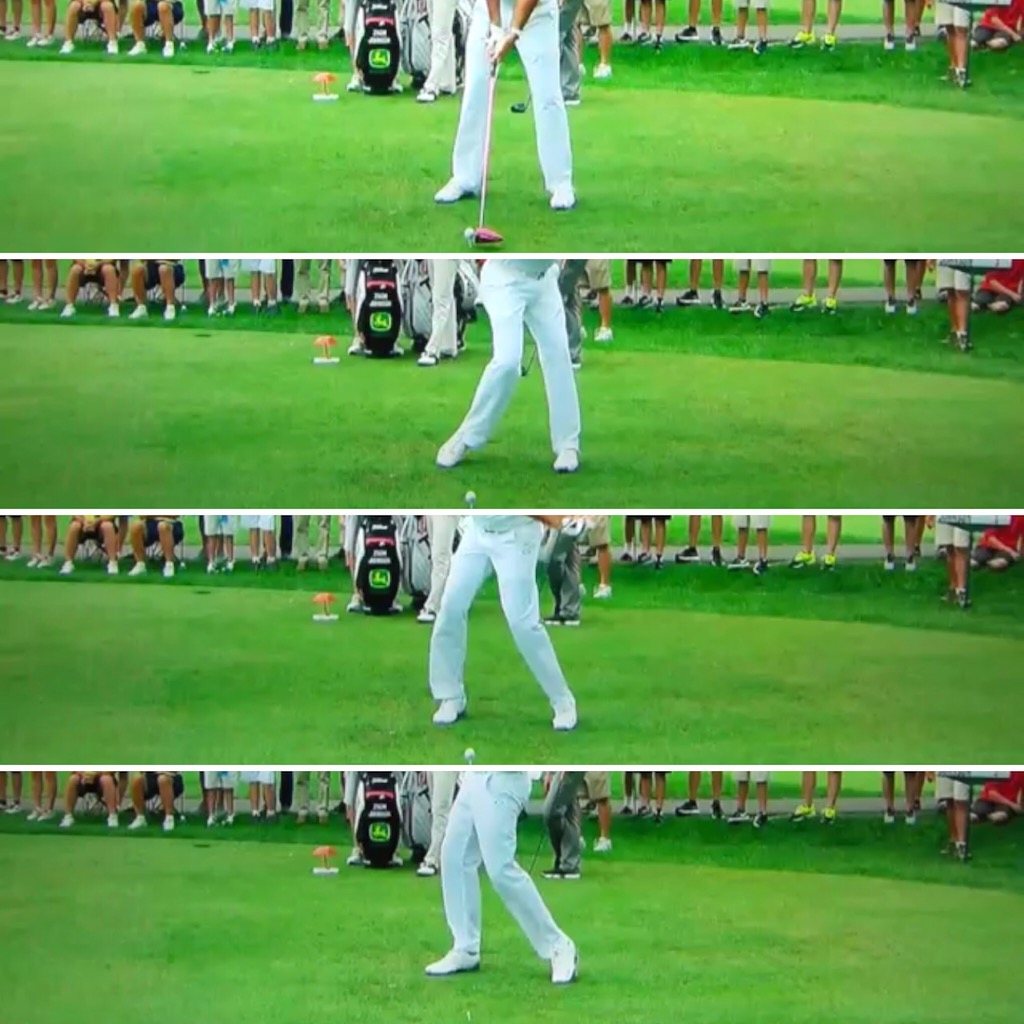Instruction
Jumping for Distance (Part 1): The Two-Foot Jump

If you follow the sport of long drive (whether as a former competitor like me or as a non-competitor) and are interested in distance, you may have come across this modern idea of squatting down during your swing and jumping up with both legs to get more power as you come through impact, even to the point of coming off the ground. In this two-part article, I’d like to share my current thoughts about this.
In Part 1, I’ll go over how I think this two-foot jump concept came about and why I don’t think it’s necessarily a good idea to implement in your swing. Part 2 will discuss the 1-foot “jump” alternative and why I believe it is better.
With the two-foot jump, I think this came about from a few things.
First, in this age of using more advanced photography to analyze golf swings, it’s possible to look at a freeze frame moment of a golf swing with great visual clarity and think that that a specific position is some key or secret to the golf swing. But it’s important to keep in mind that a single positional snap shot could simply be a split-second moment of a larger fluid motion.
Think of the Sam Snead squat. Snead was a long hitter and great player. If you take look at his down swing, he does get in to a position that looks like a squat. Because Snead was so good, I think the instruction world looked at this as some sort of key to Snead’s distance and play. Years go by and then the instruction morphs in to the squat being thought of as a key component to playing good golf.
However, looking at the larger motion, in the backswing Snead straightened his trail leg and got his weight over on his trail foot. By the time he finished his swing, this was reversed with his lead leg being straight and weight shifted over to that lead leg. It’s a relatively simple motion and in the middle of that transition, both legs happen to be slightly bent and look like a partial squat.
Second, similarly with the slow-motion footage, analysis, and interest in long hitters and professional long drivers these days, I think perhaps it started out by noticing that a player happens to have a squat look in their swing with a subsequent two-foot jump type move that gets them airborne. This again gets thought of as some type of secret to power and it starts getting taught. Before you know it in our small world of golf, multiple players have caught wind of the concept and are trying to do it. The instruction world then notices and says “Look, now multiple players are doing it! It must be the key!”, even though they are the ones who propagated it. It’s sort of like quantum theory in which the observer can affect the outcome.
Third, there could be a level of correlation vs causation taking place in which to beware. From 1999 to 2009, it was noticed that the number of people who drowned in swimming pools each year had a strong correlation with the number of films Nicolas Cage appeared in. Should Cage then not make a movie to prevent people from drowning in pools? Simply because multiple long hitting golfers are observed to squat, jump, and get airborne, it’s important to consider that this may not be what is causing the power.
Lastly, again with the advent of modern technology like force plates, one can see that longer hitters generally do generate more vertical ground forces than short hitters. It is also true that there is a strength correlation as you move from amateurs to tour players to long drivers. As I’ve mentioned in numerous other articles, long drivers tend to be incredibly strong compared to other golfer groups. Thus, it’s not unreasonable to again then make the conclusion that squatting down and jumping off the ground with two feet will generate more power and distance.
All that being said, I’d like to make the case that these long hitters are actually airborne not because of this secret “squat and two-foot jump and get airborne” move, but rather in part from a flawed setup.
I believe one of the problems in golf instruction is that we’re commonly taught to take a wider stance when we want to hit the driver or hit for more power. In some cases, this has been taken to an extreme and now some stances have become too wide. When you get too wide, ironically it becomes more difficult to maintain balance when swinging hard.
If you look at players that hit the ball long like Count Yogi, Mike Austin, Sam Snead, or John Daly, they are wide but not so wide that they can’t still have good footwork and stay in balance. When you get wider than that, which happens commonly with professional long drivers, it becomes more difficult to finish in balance on your lead foot.
This is also complicated by limited hip mobility. You can read more about this in this article, but most golfers of all skill levels have better external hip mobility vs internal hip mobility. Because of this, when you set up with your feet perpendicular to the path you want to swing on, you will likely have the lead foot external mobility to make a full enough back swing, but you probably don’t have the internal hip mobility to keep your foot in the same place and get your hips rotated all the way around to facing your target. As a built-in protection mechanism, you probably either get your weight on your lead heel and spin the foot open…or you must come off that foot completely (get airborne) to allow your leg to rotate to a position where you won’t hurt yourself.
But I’ve been asked…what about Bubba Watson? He hits relatively powerfully and has a narrower stance with an open lead foot at address.
Yes, this is true. However, notice that in his downswing, he replants that lead foot back to a position where it is more perpendicular to his swing path. Of course, then because of the limit of his internal hip mobility and the replant, he must either get airborne or spin out on that foot as a way of protecting himself from injury. If he opened his lead foot a little bit more at address and replanted back in this spot on the way down, he wouldn’t need to get off that foot to protect himself from injury.
So, to me, this two-foot squat and jump off the ground instruction is flawed.
If one were to set up with a more appropriate stance width, open the lead foot sufficiently to accommodate your own personal level of hip mobility, and not replant the foot too closed relative to the limit of your personal level of internal hip mobility on the downswing, it’s possible to maintain better balance, not get airborne, and head off potential injury while still generating huge amounts of vertical ground force.
This can be done through a one-foot jump motion…and without jumping off the ground.
In Part 2, we’ll look at how to do it.
- LIKE118
- LEGIT14
- WOW6
- LOL2
- IDHT1
- FLOP3
- OB1
- SHANK15
Instruction
Clement: Laid-off or perfect fade? Across-the-line or perfect draw?

Some call the image on the left laid off, but if you are hitting a fade, this could be a perfect backswing for it! Same for across the line for a draw! Stop racking your brain with perceived mistakes and simply match backswing to shot shape!
- LIKE0
- LEGIT0
- WOW0
- LOL0
- IDHT0
- FLOP0
- OB0
- SHANK0
Instruction
The Wedge Guy: The easiest-to-learn golf basic

My golf learning began with this simple fact – if you don’t have a fundamentally sound hold on the golf club, it is practically impossible for your body to execute a fundamentally sound golf swing. I’m still a big believer that the golf swing is much easier to execute if you begin with the proper hold on the club.
As you might imagine, I come into contact with hundreds of golfers of all skill levels. And it is very rare to see a good player with a bad hold on the golf club. There are some exceptions, for sure, but they are very few and very far between, and they typically have beat so many balls with their poor grip that they’ve found a way to work around it.
The reality of biophysics is that the body moves only in certain ways – and the particulars of the way you hold the golf club can totally prevent a sound swing motion that allows the club to release properly through the impact zone. The wonderful thing is that anyone can learn how to put a fundamentally sound hold on the golf club, and you can practice it anywhere your hands are not otherwise engaged, like watching TV or just sitting and relaxing.
Whether you prefer an overlap, interlock or full-finger (not baseball!) grip on the club, the same fundamentals apply. Here are the major grip faults I see most often, in the order of the frequency:
Mis-aligned hands
By this I mean that the palms of the two hands are not parallel to each other. Too many golfers have a weak left hand and strong right, or vice versa. The easiest way to learn how to hold the club with your palms aligned properly is to grip a plain wooden ruler or yardstick. It forces the hands to align properly and shows you how that feels. If you grip and re-grip a yardstick several times, then grip a club, you’ll see that the learning curve is almost immediate.
The position of the grip in the upper/left hand
I also observe many golfers who have the butt of the grip too far into the heel pad of the upper hand (the left hand for right-handed players). It’s amazing how much easier it is to release the club through the ball if even 1/4-1/2″ of the butt is beyond the left heel pad. Try this yourself to see what I mean. Swing the club freely with just your left hand and notice the difference in its release from when you hold it at the end of the grip, versus gripping down even a half inch.
To help you really understand how this works, go to the range and hit shots with your five-iron gripped down a full inch to make the club the same length as your seven-iron. You will probably see an amazing shot shape difference, and likely not see as much distance loss as you would expect.
Too much lower (right) hand on the club
It seems like almost all golfers of 8-10 handicap or higher have the club too far into the palm of the lower hand, because that feels “good” if you are trying to control the path of the clubhead to the ball. But the golf swing is not an effort to hit at the ball – it is a swing of the club. The proper hold on the club has the grip underneath the pad at the base of the fingers. This will likely feel “weak” to you — like you cannot control the club like that. EXACTLY. You should not be trying to control the club with your lower/master hand.
Gripping too tightly
Nearly all golfers hold the club too tightly, which tenses up the forearms and prevents a proper release of the club through impact. In order for the club to move back and through properly, you must feel that the club is controlled by the last three fingers of the upper hand, and the middle two fingers of the lower hand. If you engage your thumbs and forefingers in “holding” the club, the result will almost always be a grip that is too tight. Try this for yourself. Hold the club in your upper hand only, and squeeze firmly with just the last three fingers, with the forefinger and thumb off the club entirely. You have good control, but your forearms are not tense. Then begin to squeeze down with your thumb and forefinger and observe the tensing of the entire forearm. This is the way we are made, so the key to preventing tenseness in the arms is to hold the club very lightly with the “pinchers” — the thumbs and forefingers.
So, those are what I believe are the four fundamentals of a good grip. Anyone can learn them in their home or office very quickly. There is no easier way to improve your ball striking consistency and add distance than giving more attention to the way you hold the golf club.
More from the Wedge Guy
- The Wedge Guy: Golf mastery begins with your wedge game
- The Wedge Guy: Why golf is 20 times harder than brain surgery
- The Wedge Guy: Musings on the golf ball rollback
- LIKE86
- LEGIT13
- WOW6
- LOL1
- IDHT0
- FLOP4
- OB1
- SHANK8
Instruction
Clement: Stop ripping off your swing with this drill!

Not the dreaded headcover under the armpit drill! As if your body is defective and can’t function by itself! Have you seen how incredible the human machine is with all the incredible feats of agility all kinds of athletes are accomplishing? You think your body is so defective (the good Lord is laughing his head off at you) that it needs a headcover tucked under the armpit so you can swing like T-Rex?
- LIKE0
- LEGIT2
- WOW2
- LOL0
- IDHT0
- FLOP0
- OB0
- SHANK2
-

 19th Hole2 weeks ago
19th Hole2 weeks agoDave Portnoy places monstrous outright bet for the 2024 Masters
-

 19th Hole2 weeks ago
19th Hole2 weeks agoTiger Woods arrives at 2024 Masters equipped with a putter that may surprise you
-

 19th Hole2 days ago
19th Hole2 days agoJustin Thomas on the equipment choice of Scottie Scheffler that he thinks is ‘weird’
-

 19th Hole2 days ago
19th Hole2 days ago‘Absolutely crazy’ – Major champ lays into Patrick Cantlay over his decision on final hole of RBC Heritage
-

 19th Hole3 weeks ago
19th Hole3 weeks agoReport: Tiger Woods has ‘eliminated sex’ in preparation for the 2024 Masters
-

 19th Hole1 week ago
19th Hole1 week agoTwo star names reportedly blanked Jon Rahm all week at the Masters
-

 19th Hole1 week ago
19th Hole1 week agoReport: LIV Golf identifies latest star name they hope to sign to breakaway tour
-

 19th Hole1 week ago
19th Hole1 week agoNeal Shipley presser ends in awkward fashion after reporter claims Tiger handed him note on 8th fairway


























RBImGuy
Jan 23, 2019 at 9:03 am
Hej Jaacob
Mike Austin didn’t do this why tell people to?
Largechris
Dec 6, 2017 at 2:50 pm
Excellent article as usual Jaacob
DoubleMochaMan
Dec 6, 2017 at 10:13 am
One foot jump? Two foot jump? I’d recommend never getting more than 6 inches off the ground.
SK
Dec 5, 2017 at 10:32 pm
Well, Jaac, you really don’t understand Newtonian Physics and the difference between a ‘closed’ and ‘open’ kinetic chain…. which renders your explanations superficial.
Joel
Dec 5, 2017 at 5:13 pm
Does anyone really teach squatting and/or jumping?
I’ve never seen someone teach it on WRX or anywhere else. As you said in the middle of the article, it appears to be an effect of a massive hip rotation and not taught in order to cause it.
RBImGuy
Dec 8, 2017 at 8:34 am
Joel, PGA trainer Andrew Rice has a blog article about telling you to JUMP for power.
(Dead wrong but it is what it is with modern trainers that dont understand)
https://www.andrewricegolf.com/andrew-rice-golf/2017/10/you-need-more-power